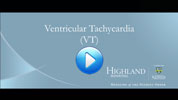Ventricular Tachycardia
 Ventricular arrhythmias are abnormal heart rhythms that originate in the bottom chambers of the heart called the ventricles. They fill with blood from the top chambers of the heart (atria) and send it to the lungs and through the aorta to be circulated throughout the body.
Ventricular arrhythmias are abnormal heart rhythms that originate in the bottom chambers of the heart called the ventricles. They fill with blood from the top chambers of the heart (atria) and send it to the lungs and through the aorta to be circulated throughout the body.
Tachycardia is a heart rate of greater than 100 beats per minute. A normal heart rate is 60 to 100 beats per minute at rest.
Ventricular tachycardia is a regular, faster-than-normal heart rate that begins in the heart's lower chambers. In most patients with ventricular tachycardia the rate is in the range of 170 beats per minute or more.
These rhythms can occur as a result of damage to the heart muscle from a heart attack or cardiomyopathy – or can occur in patients with hearts that seem structurally normal.
Ventricular tachycardia is the most common cause of death in people with cardiomyopathy.
Symptoms
-
Can vary widely
-
Some people can be relatively asymptomatic
-
Some people can feel palpitations
-
The rapid heart rate can lead to lightheadedness from blood pressure drops
-
Sustained VT can lead to fainting, loss of consciousness, cardiac arrest, or death
Diagnostic Tests
Treatment
-
ICD (Implantable Cardiac Defibrillator)
-
Ablation (radiofrequency ablation)
-
Anti-arrhythmic medications
-
Beta-blockers
Print this information
For Additional Information